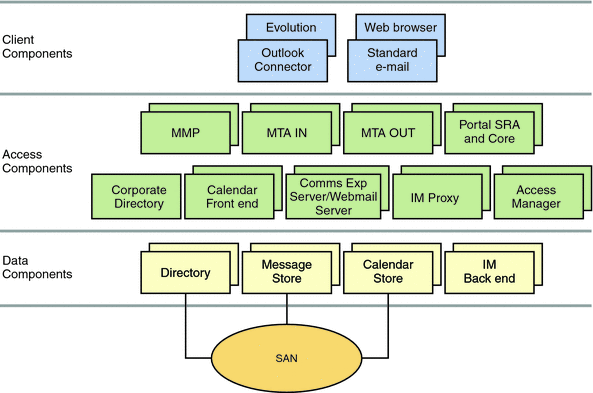Understanding Service Components and Service Tiers
When planning a Communications Suite deployment for multiple component products or services, you need to understand the composition of each component product (or service) itself.
Figure 3–1 illustrates how you can separate each service into components that can be deployed on separate hosts, and the particular tier each component occupies. Though you can deploy all components on a single host, or deploy a particular service’s components on the same host, consider moving to a tiered architecture. A tiered architecture, whether it be single-tiered, or two-tiered, provides a number of benefits. See Benefits of a Single-tiered Architecture and Benefits of a Two-tiered Architecture for more information.
Figure 3–1 Communications Suite Components

In the preceding figure, the client components consist of the Outlook Connector plugin, thick clients such as Evolution, browsers, and standard email applications. These components reside on end users’ client computers. The access layer components consist of front-end services from Messaging Server (MMP and MTA); Calendar Server; Communications Express and Webmail Server; Instant Messaging (Instant Messaging Proxy); Portal Server (SRA and Core); Access Manager for authentication; and a corporate directory, which provides address book lookup. The data layer components consist of back-end services from Directory Server (which, in itself, can consist of front-end and back-end components); Messaging Server (Message Store); Calendar Server (Calendar Store); and Instant Messaging. A Storage Area Network (SAN) “cloud” represents the physical data storage.
Note –
The corporate directory shown in this figure is not a component product in itself. It represents a “copy” of the corporate directory that enterprises typically deploy in the access layer for clients to perform address-book type lookups.
The following sections explain these various components in more detail.
- © 2010, Oracle Corporation and/or its affiliates
